Air Source Heat Pumps and Hot Tubs
Everything you need to know about air source heat pumps for hot tubs and why you should buy one.
The cost of running a hot tub just got expensive.. We are all aware of the price cap increase on electric and the larger bills we will all be receiving over the next few months… So how can we run a hot tub with these potentially ridiculous running costs??…. Read on….

How does your hot tub work today?
The vast majority of hot tubs in homes and holiday cottages run on electric. A mains power feed is brought to the Hot Tub from the house mains and will be either a 13amp feed (known as plug and play) or a larger capacity 32amp feed used for bigger tubs with multiple pumps etc.
Irrespective of the feed, the tub will have an electric element within the tub which water is passed over/through in order to heat the water. Think of a kettle heating element and that’s basically what the tub has. Elements range from 2kw upwards, depending on the size of the tub and the volume of water. For the most part, the majority of tubs have either 2kw or 3 kW elements.
When a tub is filled with cold water, the hot tub “brain “will check the temperature of the water compare it to the temperature you have asked for on the hot tub Control Panel. If you have asked the tub to heat to 39 degrees and the water is at 10 degrees, the tub will click the heater on until the water hits that desired temp – so the heating elements task is to raise 1200 litres of water by 30 degrees using its heating element.
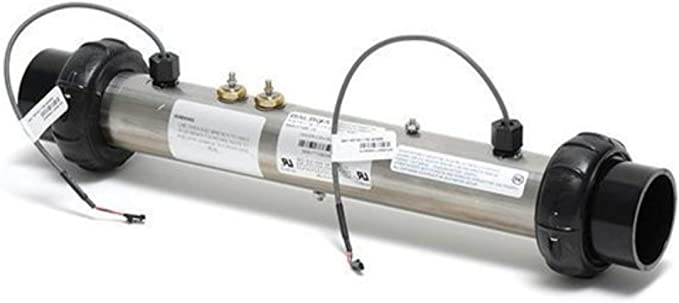
2kw vs 3kw vs 6kw Elements – What’s the difference?
Simply put – the greater the heater element size – the faster the tub will heat up – so a 6kw heater will heat a tub up 3 times faster than a 2kw element – BUT it will use 3 times the amount of electricity as a 2kw element…and there is the problem. A 3kw heater will use 3kw of electricity all the time its on. So if it takes 10 hours to heat your tub up to temperature that’s 3kw * 10 Hours = 34p per hour x 30kw hours = £10.20
Electric heaters match their KW rating exactly to the electric price per kwh. Its a direct 1:1 relationship and that’s the problem we need to solve to keep the costs sensible.
Enter the air source heat pump
What is an Air Source Heat Pump?
Simply put, its like an Air-conditioning unit – but in reverse. We all know an air conditioning unit takes warm air in from the outside and cools it through a process using refrigerant to drop the temperature of the air coming in hence the coldness of aircon. An Air source heat pump does the reverse. It takes cold air in and through a process using refrigerant, the air is heated up and this air can then be used to heat the water in a hot tub. The key element that we need to understand here is that the chemical process is NOT a direct 1:1 relationship as per the electric element detailed above. An air source heat pump offers a significant efficiency multiplier – anywhere between 3 and 5 depending on ambient air temperature and the heat pump specification.
So what that means is that for every 1kw of energy put into an air source heat pump, the resultant energy output is greater ( 3to 5 times greater in fact)
Once we connect an air source heat pump into the heating circuit of a hot tub we are able to heat the tub a) Much quicker and B) much cheaper which offers greater efficiency and lower total cost of ownership.
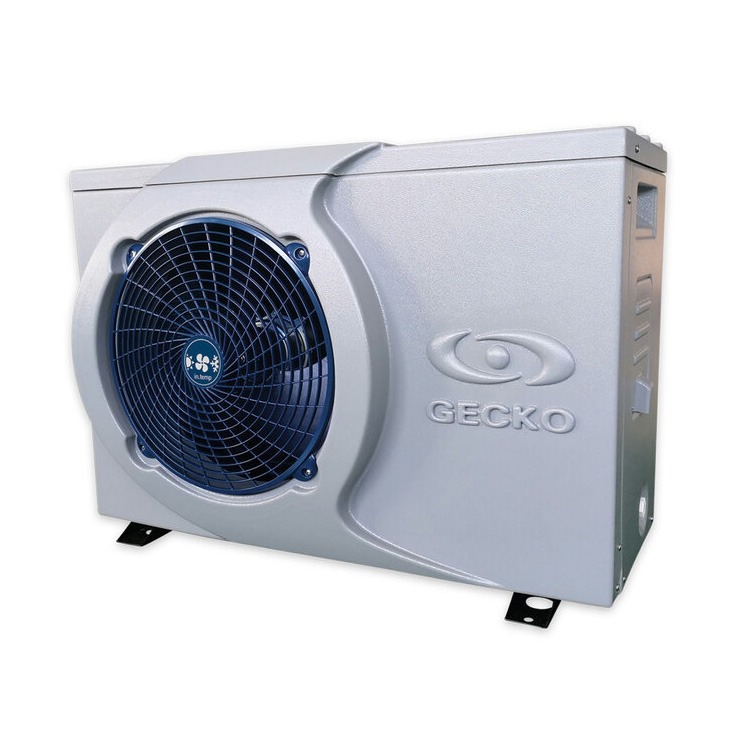
How is an air source heat pump fitted to a hot tub?
The pump is fitted externally to a hot tub and required plumbing in and an electrical connection made. They take about 2 hours to fit and setup and once programmed are just left to run and do their thing. The existing electrical heater is left in situ in the tub and the air source pump works in conjunction with the hot tub heater to heat the tub when heat is required but using 3 to 5 times less electricity.
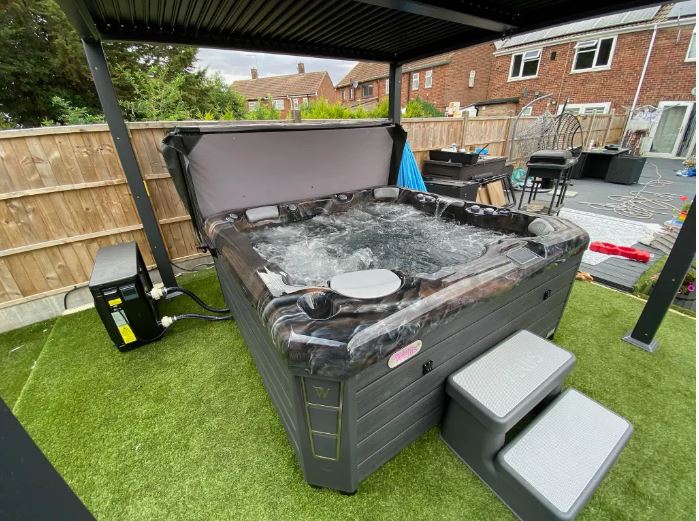
How much will I save by installing an Air Source Heat Pump to my hot tub?
Lets look at the normal hot tub scenario of an electric heater only and use a 3 kw heater as an example.
The table shows the approx. costs of the initial heat up from cold and then the ongoing running costs to maintain a tub at 40 degrees . We have shown 3 examples of 2,4 and 6 hours a day to run the heater and this obviously depends on a number of factors – use of the tub, surroundings, wind chill , tub insulation etc.
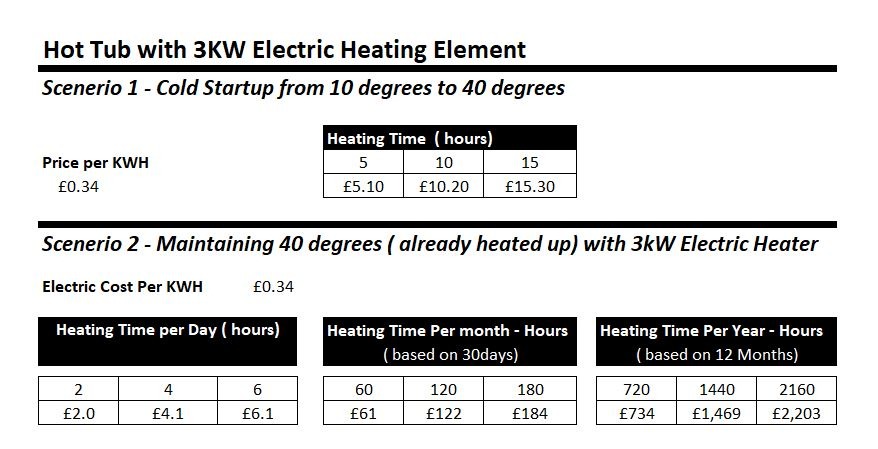
Now, lets add a 5kw heat pump to the same tub and see the results.
Using the same multipliers and heat time examples, the ASHP offers a 1:3 or even 1:5 energy efficiency mutiplier – remember for every 1kw of energy put IN, we get somewhere between 3 kw and 5KW of heat output.
The cost reductions are quite staggering – even at 1:3 efficiency we are projecting an annual reduction from £2200 down to £734 – which more than pays for the heat pump in year one. Look at that over 3 to 5 years and the heat pump is a very viable option.
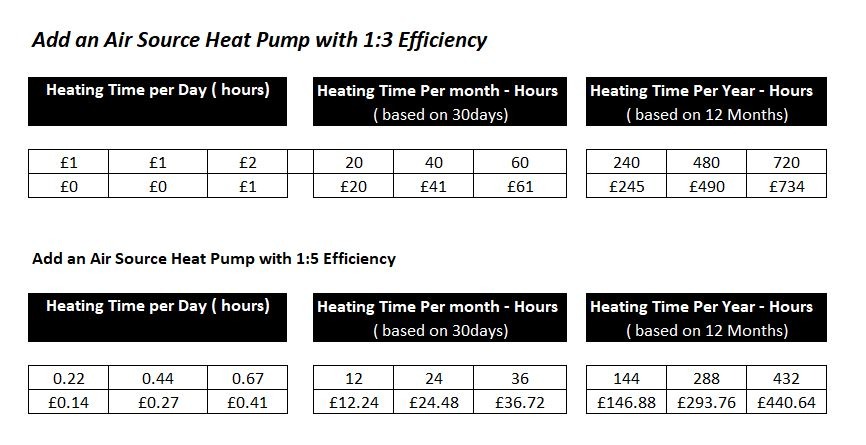
Conclusion
So, should you fit an air source heat pump?
We think, based upon the information we have detailed above, its almost a no brainer. if you own a holiday let or holiday cottage and are refilling and reheating a hot tub on a regular weekly basis, the savings in electric are going to be astronomical.
If you have a hot tub at home and want to keep the use of electricity as low as possible and enjoy your tub, then again, yes this is a no brainer and it will return the investment easily for you.
Disclaimer
its important to remember that every tub is different, every install location is different and everyone’s use of a tub is different so its very hard to say EXACTLY what the actual savings will be. All we can say is given the efficiency multiplier of a heat pump, its cannot help BUT save you money however we need to state this caveat.

